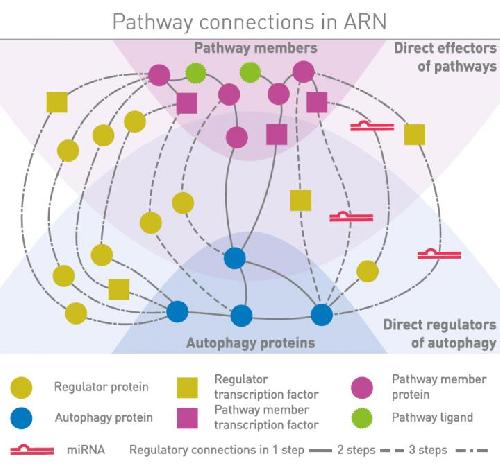In this comprehensive review with over 2,450 authors, the topics covered reflect the range of specialist fields within autophagy, and the diversity of animal, plant and fungal cell types that must inevitably invoke autophagy. Even within a single species or organism, the complexity is such that autophagy can be divided into many types.
Autophagy, in general, means 'biological self-destruction'; it exists in all eukaryotes, including unicellular parasites, plants, fungi and animals. Autophagy is usually considered as a stress response mechanism used under conditions of starvation, infection and diseases such as cancer and neurodegeneration. It is also important in normal development, gut function, wound healing, and (healthy) ageing.
In such cases, autophagy involves the degradation of material in double membrane 'autophagosomes' within cells. As the core autophagy process involves several dozen proteins, their precise and context-dependent regulation requires many further proteins and different mechanisms.
 TGAC's Autophagy Regulatory Network resource provides an integrated and systems-level source for autophagy ('biological self-destruction') research in humans, features in the recent "Guidelines for the use and interpretation of assays for monitoring autophagy". Credit: TGAC
TGAC's Autophagy Regulatory Network resource provides an integrated and systems-level source for autophagy ('biological self-destruction') research in humans, features in the recent "Guidelines for the use and interpretation of assays for monitoring autophagy". Credit: TGAC
The third edition of this Guideline review provides recommendations for best practices, particularly with regard to monitoring and measuring autophagy, and diagnosing/describing the type of autophagy being investigated - multiple assays are currently required and the appropriate choice of these depends upon the question at hand. A major addition to this new version is the presentation of computational tools and resources developed in the last few years to assist autophagy researchers in data analysis and data sharing.
One such resource featured in the review is the Autophagy Regulatory Network database (1), which provides an integrated and systems-level source for autophagy research in humans.
The Autophagy Regulatory Network can be used to analyse autophagy for both global or for gene-specific studies. Currently, it contains data on more than 14,000 proteins, including 38 core autophagy proteins and 113 predicted regulators. A flexible download functionality enables users to customize and filter the database.
Dr Korcsmaros, who contributed the last chapter of the study, said: "We published the Autophagy Regulatory Network exactly one year ago. Since then, the cell biology and autophagy community have started to use it, provided feedbacks and allowed the analysis of autophagy-related systems at a level that was not possible before. Featuring this resource in this key publication (receiving over 2,000 reads just in the first two days), and listing TGAC and IFR among the 2,135 key institutes studying autophagy is a great acknowledgement of our work. We hope that this third edition will serve the community with relevant protocols and tools to study autophagy."
The publication, titled: "Guidelines for the use and interpretation of assays for monitoring autophagy" is published in Autophagy (2).
source: The Genome Analysis Centre